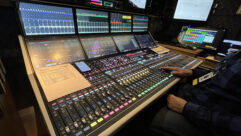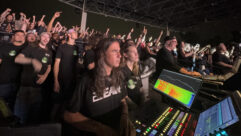SAFETY HARBOR, FLORIDA – OCTOBER 2013:
When we caught up with him, Bob Coke was drawing on his decades of FOH experience to mix The Black Crowes with the help of Metric Halo’s SpectraFoo sound analysis software as the band toured the U.S. in the fall of 2013. The path that took Coke from a “penniless” musician with proficiency on Indian Tablas, sarod, and acoustic guitar to the trusted ears of one of the biggest rock acts of the modern era is a case study in serendipity well-played. Shortly after love relocated Coke – still a struggling musician – from his American home to France in 1980, a friend who had relocated to Los Angeles called him up. That friend, J.P. Plunier (who now owns Everloving Records), had started managing a singer/songwriter Ben Harper and needed someone with a European license to drive the band around on their first European tour. Coke obliged and, trustworthy and capable soul that he is, was promoted to tour manager within the first week. With the new role came responsibility to help with the backline, to help with the monitor mix, and to mix the band at FOH.
“All of this was a very ‘seat-of-the-pants’ learning experience,” Coke laughed. “There was lots of trial and error… oh yeah, lots of error! [laughs] My ears and previous music experiences helped me a lot, as did several sound engineers that I met along the way. After two years, I made the decision to stop the road manager duties and concentrate on sound engineering, which I was (and still am) truly passionate about.” Coke observed that the musical and cultural palette in Europe at the time was much more diverse than it was in the U.S. Mixing, both live and studio, was a wide open field with only a few key players. So in an indirect way, Europe was an exciting and encouraging place to live and work for someone with a good head on his shoulders, a musician’s ears, and a passion (though no formal training) for mixing.
Between then and now, Coke has worked with a broad array of musicians. He said, “My proudest moments are those I’ve spent together with incredibly talented musicians while they created or expressed music: waking up at 4 a.m. to sing with Rahim Fahimuddin Dagar; all the recordings and concerts playing Tablas with New York’s finest soprano saxophonist, Eric Person; co-producing Ben Harper’s second album, Fight For Your Mind and the subsequent tour; recording pianist Pete Drungle; recording, mixing and touring with French rock band, Noir Désir as well as the French singer, Alain Bashung; touring with Grammy-winning French band, Phoenix; and, of course, touring with The Black Crowes. And there are so many others. That’s just a start.”
Coke stumbled upon Metric Halo’s SpectraFoo after complaining to Marco de FouquiA¨res of Dispatch/Dushow (the largest sound company in France) that there seemed to be no Mac-based sound analysis software. FouquiA¨res alerted Coke to SpectraFoo, which is proudly and only Mac-based. “At the time, there was a huge shift in our approach to system installations with the arrival of the L-Acoustic line array, concurrent development of sound analysis software, and the way that sound analysis software was being applied in the field,” recalled Coke. “Every system tech here in France was using the same software, but I opted for SpectraFoo. I quickly recognized SpectraFoo to be a more precise measuring tool that proved equally useful in the studio environment. The Dolby Lake EQ corrections I make are the exact same frequencies Spectra Foo indicates, whereas the PC software frequencies at the time were generally off by several Hertz. This was a cause of consternation with several of my system techs. They went so far as to upgrade their ADDA audio interfaces… but still without achieving a more accurate reading!”
These days, Coke runs SpectraFoo on all of his tours. He uses it to align the mains, the subs, front fills, side hangs, and delays, and he uses it to analyze room acoustics and the room’s response to amplified sound. For both live and recording applications, Coke uses SpectraFoo to verify phase rotation and to visualize tonal balance. “SpectraFoo gives me a visual reference for what I’m hearing and can help me identify in real time what’s occurring acoustically,” he said. “It is an invaluable aid in live sound reinforcement because the working environment is extremely fluid and composed of constantly changing variables. As well, any changes in the sound are immediately perceived by the audience though perhaps not always consciously. I refer to a broad palette of tools in SpectraFoo from the moment I’m powered up and running in an empty venue until the end of the show and I’m measuring audience applause after the artist has departed the stage.”
Although The Black Crowes represent a return to straight-up rock ‘n’ roll and although Coke mixes them in that vein, he asserts that modern sound reinforcement equipment would not respond well to a retro approach to system tuning. “Live sound has evolved dramatically in the past twenty years. As the precision of FOH sound systems has increased, the room for error has decreased. Nowadays, speaker technology and system tuning can be very unforgiving to a bad sounding mix – or even a mediocre sounding one. In our modern day-to-day lives of digitized mp3 sound and small speakers, going to a rock concert can and should be a felt experience. SpectraFoo helps me dial in that experience quickly by providing an accurate visualization of what my ears are hearing, thereby complementing my aural understanding with a purely scientific visual reference.”
ABOUT METRIC HALO
Now based in the sunny city of Safety Harbor, Florida, Metric Halo provides the world with high-resolution metering, analysis, recording and processing solutions with award-winning software and future-proof hardware.










